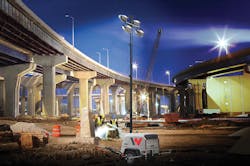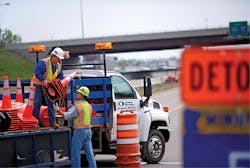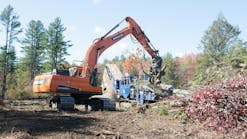Work site support equipment is key to a project’s productivity, efficiency, and safety.
“A lot of people don’t think about work site support equipment,” says Teska T. Dillard, vice president/operations for Votum Enterprises in Orlando, FL.
“If they’re not planning for it, they won’t use it,” he adds. “There is some great stuff out there that can make your life a lot easier but you won’t know that you need it unless you do the planning prior to it.”
Without planning, “once you get into the construction, you’re going to be reacting to what’s going to be happening, and that’s never a good thing,” says Dillard. “You want to understand prior to construction what’s going to happen, when it’s going to happen, and if something outside of your plan does happen, you know where to get that support equipment.”
Over its nearly 10 years in business, Votum—a minority- and woman-owned small business enterprise general contractor construction management firm—has been involved in a number of small to high-profile projects, including its current work partnering with Hensel Phelps in expansion work at the Orlando International Airport.
The company’s projects are conducted both day and night, with night construction often being dictated by the need for an institution to not have its own operations impacted during the course of the day.
Before Votum’s crews set foot on a project site to begin work, the company puts together a site logistics plan, irrespective of whether the construction is at an existing facility or is new construction.
“Prior to starting any work, you should sit down and create a plan that encompasses all of what could happen, what you are doing, what you are affecting, what equipment is needed, what is the backup plan should something go wrong, where are the shutoff valves if I hit a water line, what equipment is needed for the site to be safe and secure, is there appropriate lighting, and will we be making too much noise,” says Dillard.
Typically, contractors set up power first on a work site, notes W. Ben Bradshaw, United Rentals district sales manager, Mid-Coast district.
“Most projects start with temporary power to get the trailers set up,” he says. “If lights are needed, they will be set up later or portable light towers will be rented temporarily.”
Typical support equipment includes water trucks and rubber tire and track dozers, notes Bradshaw.
Support equipment plays a crucial role in increasing productivity and safety and getting the job done, points out Bradshaw.
“If the site is too hard or dust control is an issue, you can bring in more water trucks to get this done,” he says. “If productivity is an issue, you can increase or decrease the amount of gear on site to finish the project.”
Votum’s plan covers areas where the construction activities may impact normal egress.
“We are making sure people can get in and out of the site with no issues,” says Dillard. “We start with safety in mind first before we do anything else. Then we roll into the hard items like utilities to make sure we’re not impacting those. If we are, we set up steps prior to shutting anything off with that particular owner or property manager and make sure we’re not turning somebody’s power off without them knowing it.”
From there, the company secures the site by setting up fencing with temporary barriers.
“Once we know the site is secure and under our control, then the rest of the work can get started,” says Dillard. “There is a lot of the upfront planning and managing element. The last thing you want is to start work and have people walking into your site inadvertently, or you’re shutting services down that shouldn’t be shut down, or disturbing or impacting that property manager or that facility or owners and stakeholders. Once that happens, you’ll get the phone calls.”
In terms of “must-have” equipment on the job site, barriers to close off a site are a definite necessity, notes Dillard.
“Being able to lock things up is another factor—being able to make sure that day to day people can’t get in and out of your site” is important, notes Dillard.
It’s also important that there are filter barriers for HVAC ventilation, “especially if you’re doing demolition—making sure you’re not sucking that dust into the system,” says Dillard. “A lot of people forget about that. They start construction and the return air system brings in the dust and now they’ve dirtied up the air conditioning system for the owner.”
Votum crews also carry sound meters.
“A lot of times people don’t think about that, but they are necessary if you start getting over 85 decibels where you impact hearing. It’s good about taking readings and making sure what impacts we’re having on the facility or if it’s out on the construction site, we understand what’s going on there,” says Dillard.
Security on the job site ranges from portable security cameras strategically placed near the entrance of the project to security guards on site after hours, says Bradshaw.
To protect the site over a 24-hour period or know who comes in and out of the site, Votum uses security cameras such as Eye Trax.
Eye Trax is designed as a security camera solution for locations that don’t offer power or an internet connection. The solar-powered camera transmits over a cellular network to the company’s cloud-based software.
Video is captured from motion-activated events and images are captured on a schedule for time-lapse video creation. The camera systems will send late-night text message notifications of nighttime site disturbances.
Jerry McSorley, the owner of Eye Trax, invented the solar-powered camera system in 2007 after having spent his working life in construction and land development and wanting a product that would monitor all of his sites.
Job site cameras are being widely adopted to provide live and recorded surveillance video, alerts, and incident documentation, notes Wendi Burke, director of marketing, Sensera Systems.
“Comprehensive solutions will include multiple sensors such as thermal, low-light, and color to ensure site activity is captured even in the lowest light environments; video analytics to trigger recording and alerts on motion detection; cloud-based and edge on-camera recording and video management; and the ability to function without AC power or when power is cut. Solar-powered cameras with battery backup are the best.”
Solar-powered camera technologies by companies such as Sensera Systems have been adopted by more than 1,000 general contractor end-users in order to increase productivity, improve stakeholder communications, and avoid costly rework and risk, says Burke.
“Since solar-powered cameras do not require infrastructure such as power and internet to be in place for installation, they can be quickly and easily deployed in remote locations,” she adds. “General contractors managing multiple projects can save travel time and expenses with the ability to oversee multiple sites from a single dashboard.
“Stakeholders can communicate and collaborate from anywhere, anytime, via laptop, tablet, or mobile device. This flexibility allows project managers to monitor progress, deliveries, subcontractors, proper material handling, safety compliance, and a host of other aspects of a live and chaotic job site while collecting visual documentation throughout the project duration.”
A security camera should be one of the first pieces of support equipment to be placed at a job site to monitor all of the equipment and materials that are in the process of being delivered, as well as job progress, says McSorley.
Additionally, the electrician runs temporary power to the site and then possibly lights if the site needs it, as well as a water supply, he adds.
Some larger sites also utilize badges or other access control, requiring card readers that provide information on who is coming on and off the site, says Dillard.
Dillard says his company will provide some type of power source for construction work.
“If we do have generators, they are normally for our remote locations. If we’re working near an existing structure, we try to bring in temporary services, especially if we need power,” he says. “It depends on the power needs and the same is true with water sources. That’s part of that logistics plan we put together before we start work.”
Special lighting provisions such as flood lights are made for night work to help illuminate the job site, especially when doing excavation, Dillard says.
“And you can go with something as big as a light stand that has a generator and it powers up lights for a significant period of time to light a larger area,” he adds.
In the lighting arena, Doosan Portable Power has expanded its product line of portable light towers with the addition of the LCV6 and LCV8 models.
Both the LCV6 and LCV8 light towers are designed with a small-body design and vertical mast, which allow for greater maneuverability, ease of transport, and low operating cost.
The clamshell-style canopy is designed of lightweight composite material for easy access to internal components for regular maintenance.
Both LCV light towers are standard-equipped with a vertical mast manually extending to 23 feet to reduce setup time and improve transport safety.
The LCV6 and LCV8 are 82 inches long and 55 inches wide, with a travel position height of 101 inches. With a compact footprint, 17 units can fit on a standard flatbed trailer for more cost-effective transportation.
Both LCV models have a 52-gallon diesel fuel tank. The LCV6 and LCV8 have minimum runtimes of 119 hours and 97 hours respectively, with four 1,050-watt metal halide lamps.
For longer runtimes, the LCV models can be equipped with high-efficiency LED lighting. These 290-watt fixtures provide glare-free lighting and nearly double the runtime—210 hours for the LCV6 and 180 hours for the LCV8.
The LED fixtures are maintenance-free, rated for 50,000-hour life, and covered by a five-year warranty.
The LCV6 is powered by a Tier 4 Final-compliant Kubota D1005 diesel engine with a Mecc Alte 6-kilowatt (kW) alternator. The LCV8 is equipped with a Tier 4 Final Kubota D1105 engine and Mecc Alte 8-kW alternator, designed to provide operators with the flexibility to connect small tools and other electrical devices to the LCV receptacle panel.
The 1,000-hour oil change interval is designed to help reduce the total cost of ownership with fewer maintenance costs.
Optional features for both LCV models include fluid containment, electric winch, auto start/ stop control, low fuel shutdown, and telematics package.
Dillard points out it is necessary to put in place a plan that meets transportation department guidelines for redirecting pedestrian and vehicular traffic through a construction zone.
“You’re supposed to put a plan together and get a permit for that plan,” he says. “We normally go to specialized subcontractors who put a plan together for us to make sure we have an adequate number of signs, cones, arrows, and directional information. It needs to be well ahead of whatever construction activity you might be impacting on the road—from a few thousand feet to a hundred thousand feet—so folks can have time to make their adjustments.”
Bradshaw points out that among the factors to consider when placing traffic calming equipment at the work site is the speed limit on the road on which equipment is being placed “so you don’t cause an immediate slow down for commuters, which in turn can cause an accident to other commuters or the individuals placing the equipment.”
“The other is the safety of the employees who will be conducting the work,” he adds. “You want to ensure they are out of harm’s way and can perform the work needed to stay safe. The contractor always is looking to ensure the safety of both the commuter as well as the employees conducting the work.”
Gates and grated egress points calm traffic because the vehicles have to travel slowly, says McSorley.
“On the way back out, most of the time the vehicle is required to wash off over the metal grated egress point prior to entering the public roads. Contractors are liable for dirty roads,” he adds.
Putting together a site logistics plan helps drive work site productivity and efficiency, Dillard points out.
“If you’re not planning for these items early in the start of the work, you may shut down power or hit a line that you didn’t previously try to survey or make sure it wasn’t active. You didn’t do your underground or ‘prior to digging’ procedures to call folks out to make sure you’re not hitting any type of underground utilities.
“If you’re not doing any of that early on, then you can run into some issues and hit a water line or something you didn’t plan for. It stops your project and you have an upset owner who said you should have done your homework.”
Despite the best plans, some unanticipated events can occur, which necessitates a back-up plan to mitigate whatever may take place, Dillard says.
An example: digging without appropriate lighting. Not only does that set up a construction company’s activity for a shutdown from a safety standpoint, but it also can compromise the quality of the work, Dillard points out.
Another example: cooling units are a necessity if during construction a company takes down the power at a facility during the summer heat and there is no cooling available.
“Once you take it down and realize you need cooling equipment, it’s too late,” he says. “The finishes are now susceptible to moisture and heat and you can damage some finishes inside of the building or have people inside of the facility that need cooling and you don’t have anything for them.”




